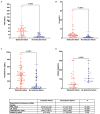Gonadal function in pediatric Fanconi anemia patients treated with hematopoietic stem cell transplant
- PMID: 36891729
- PMCID: PMC10483354
- DOI: 10.3324/haematol.2022.282094
Gonadal function in pediatric Fanconi anemia patients treated with hematopoietic stem cell transplant
Abstract
Gonadal dysfunction and reduced fertility are clinical manifestations well described in patients with Fanconi anemia (FA) and following hematopoietic stem cell transplantation (HSCT). It is difficult to differentiate gonadal dysfunction from the primary disease itself or from HSCT procedures. Therefore, it is important to manage expectations about gonadal failure and infertility for all patients with FA, regardless of the HSCT status. We performed a retrospective analysis of 98 pediatric patients with FA who were transplanted between July 1990 and June 2020 to evaluate the incidence of gonadal dysfunction in female and male patients with FA. New-onset premature ovarian insufficiency (POI) was diagnosed in a total of 30 (52.6%) patients. Follicle-stimulating hormone and luteinizing hormone levels were increased in patients diagnosed with POI. Anti- Mullerian hormone levels declined in POI patients after HSCT (r2=0.21; P=0.001). Twenty (48.8%) male patients were diagnosed with testicular failure. Follicle-stimulating hormone levels increased after HSCT even in patients without testicular failure (r2=0.17; P=0.005). Inhibin B levels decreased over time after HSCT in patients with testicular failure (r2=0.14; P=0.001). These data indicate brisk decline in already impaired gonadal function in transplanted children with FA.
Figures




References
-
- Alter BP, Frissora CL, Halperin DS, et al. . Fanconi's anaemia and pregnancy. Br J Haematol. 1991;77(3):410-418. - PubMed
-
- Giri N, Batista DL, Alter BP, Stratakis CA. Endocrine abnormalities in patients with Fanconi anemia. J Clin Endocrinol Metab. 2007;92(7):2624-2631. - PubMed
-
- Butturini A, Gale RP, Verlander PC, Adler-Brecher B, Gillio AP, Auerbach AD. Hematologic abnormalities in Fanconi anemia: an International Fanconi Anemia Registry study. Blood. 1994;84(5):1650-1655. - PubMed
-
- Mathiesen S, Sorensen K, Nielsen MM, et al. . Male gonadal function after allogeneic hematopoietic stem cell transplantation in childhood: a cross-sectional, population-based study. Biol Blood Marrow Transplant. 2020;26(9):1635-1645. - PubMed
MeSH terms
Substances
LinkOut - more resources
Full Text Sources
Medical

